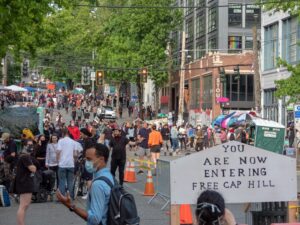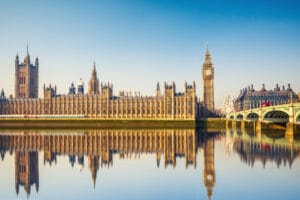The unparalleled global reaction to the May 25th death of George Floyd has put a spotlight not just on why we protest but how. The sometimes-violent escalation of protests is not welcome by most in society and various theories exist on why this happens. Professor Clifford Stott, Professor of Social Psychology at Keele University, says George Floyd’s death and similar incidents can “become a trigger moment because it symbolises a broader experience, amongst much larger numbers of people, about the relationship between Police and the black community.” He goes on “You can’t think about Police brutality, and the profiling of certain communities, without thinking about the inequalities that exist in society and fuel those concerns… You could argue even the Police killings are symptoms – the underlying cause is white supremacy, racism, and things the US (United States) has not fundamentally dealt with.”1
Antiquated and debunked classical explanations for crowd behaviour include “mad mob theory” where sense of self, reason, and rationality are lost and the person behaves not as they would normally and “the bad leading the mad” where outsiders or professional agitators take advantage of the crowd using their supposed gullibility. They do however fail to take account the “factors that actually drive such confrontations.” In fact says Stott, “when people riot, their collective behaviour is never mindless. It may often be criminal, but it is structured and coherent with meaning and conscious intent and these behavioural limits of crowd action relate in important ways to the limits of social identification”.2
Matthew Legge argues such escalating violence makes the public feel unsafe and popular support can change from supporting the protest to supporting law and order. Legge quotes Tay Anderson, who helped organise the George Floyd protests in Denver, “When we aren’t asking people to destroy things in our name and people do it anyway, we know that this is something that’s going to blow back on us.”3 This belief is further reinforced by the response from the people of London a few years after the 2011 London Riots when the Mayor of London office of Policing and Crime polled its citizens with regards to the proposed purchase of a water cannon. The results from 4,200 Londoners revealed ‘Police officers have the right to defend themselves, the public and businesses’ ‘A water cannon would be a useful last resort in extreme circumstances and Police should have all possible tools available to them to deal with disorder’. Furthermore, following the London riots of 2011 Londoners felt the Police lost control and that a water cannon may have been useful. This study also found “Despite having lower general levels of trust in the Police, black Londoners by a margin of more than 3 to 1, are more likely to think a water cannon would be useful in policing London than not (61 against 19%).”4
In the United Kingdom (UK) the House of Lords and House of Commons Joint Committee on Human Rights published a report into policing protests in 2009 that suggests improving dialogue between the Police and protesters with ‘no surprises’ for Police or protestors and regular human rights training for the police. 5 A measured police response as suggested above and earlier by Professor Stott was clearly evident in Bristol last week when protestors removed the controversial statue of British slave trader Edward Colston. Police Crime Commissioner for Avon and Somerset Sue Mountstevens fully supported her Superintendent Andy Bennett in his decision not to have his officers intervene stating the command team had “carefully considered all the implications of sending in officers at that moment to make arrests, probably requiring them to use force and the escalation of tensions that could be caused as a result. I am confident that, after the Police assessed the circumstances, they not only made the right decision, but they also did the right thing to prevent any escalation of tension into violence, injury or worse.” 6
Whilst there is no evidence to suggest the recent Black Lives Matter protests in the UK escalated to looting, this was certainly the case in the US. Vehicles were driven into crowds and members of the public were injured during the tensions that unfolded. The US Police response seems to be a lot less measured than that in the UK. Curfews, rubber bullets, tasers and tear gas have been used in a bid to bring the protests under control. Speaking to The Insider Scott Thomson, Former Chief of Police in Camden, New Jersey, believes “for Police, there’s this failed mindset of ‘if we show force immediately we will deter criminal activity and even though that approach hasn’t worked… attempts at policy reform and training have still yielded little change.” Deputy Commissioner for the Baltimore Police Department Jason Johnson also suggests “safe, responsible policing requires good policy, adequate training, and strong accountability measures” as the way forward. He also added “If you look at the time order of things, you develop the best policy you can, and then you train your officers on those policies as thoroughly as you can… but asking an officer to just read a policy and be able to follow that policy in real life is not practical,”. He goes on to further suggest that de-escalation training should be more intensive, and scenario-based but this is too expensive. 7
It has been widely publicised that groups with their own political agenda send ‘professional’ agitators into the melee to stir up the crowd with a purpose to create a tense and uneasy atmosphere and to further exacerbate the situation. For example, during recent Black Lives Matter protests the social media platform Twitter suspended the account of a white supremacy group believed to have incited violence by deliberately posting false information.8 But even the term ‘agitator’ is divisive as it was used by white Southern Americans to describe Dr Martin Luther King Jr. Professor of Sociology and African American history at Northwestern University Aldon Morris suggests “blaming the unrest to outsiders implies that the majority of oppressed people are content with the status quo”. 9
To quote Dr Martin Luther King… “injustice anywhere is a threat to justice everywhere. We are caught in an inescapable network of mutuality, tied in a single garment of destiny. Whatever affects one directly, affects all indirectly.”10 Perhaps this message has finally started to break through as Police officers around the world join protestors in unison by taking the knee.


